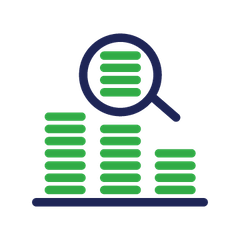Business Intelligence (BI)
What is business intelligence (BI)? It has been defined in many ways. By the earliest definition (1958), business intelligence was explained as “the ability to apprehend the interrelationships of presented facts in such a way as to guide action towards a desired goal.”
A broader and perhaps more current definition of this discipline is this: business intelligence is the process of collecting business data and turning it into information that is meaningful and actionable towards a strategic goal. Or put even more simply, BI is the effective use of data and information to make sound business decisions. While it might not sound like it, BI is different from analytics.

Reporting
The process of accessing data, formatting it and delivering it inside and outside the organization

Analysis
Identifying patterns and establishing relationships in a group of data

Data Mining
The extraction of original information from data

Data Quality & Interpretation
The greater or lesser correlation between data and the real-world objects they represent

Predictive Analysis
A branch of data mining, it attempts to predict probabilities and trends
Reporting and analysis are the central building blocks of business intelligence, and the arena in which most BI vendors compete by adding and refining features to their solutions.
The general process of business intelligence is as follows:
- Gathering data and organizing it through reporting
- Turning it into meaningful information through analysis
- Making actionable decisions aimed at fulfilling a strategic goal
Data: The Raw Material
The raw material of business intelligence is the data that records the daily transactions of an organization. Data may come from such activities as interactions with customers, management of employees, running of operation or administration of finance. According to the traditional model, data from daily transaction is recorded in three main transactional databases: CRM (customer relation management), HRM (human resource management) and ERP (enterprise resource planning). For instance, a sales transaction would be recorded and stored as a piece of data in the CRM database.
A piece of data, in itself, is neutral–i.e. neither “good” nor “bad.” For instance, if you knew that rep X had received Y dollars worth or orders year to date, you wouldn’t necessarily know whether it’s a cause of panic or celebration.
Just like raw material, data needs to be processed through analysis to become meaningful. The same piece of data in the example above would become meaningful (for instance) if compared to year-to-date sales target for rep X. By doing this, the piece of data has become part of the process of analysis.
Analysis: Contextualizing the Data
Analyzing data means asking it questions and getting meaningful answers. For example, the simple command “sort in descending order” on a column of data in Excel representing year-to-date orders taken by sales rep would answer the questions “Who is taking the most orders? The least orders?” The sort command has contextualized the data, making it much more meaningful in terms of the strategic goals of the business.
Of course, analysis in BI is much more complex and varied than this. The powerful and interactive analysis tools of today’s better business intelligence solutions make it easier to ask data an increasing number of questions and getting meaningful answers–including “what-if” scenarios, multidimensional slicing and dicing (XOLAP analysis), mashing up of data with geographic mapping and much more.
Goal of Features
Enabling decision-makers to understand data, to spot patterns between numbers, to identify trends and the reasons behind them–simply put, to contextualize data and answer questions about it.
In any case, the goal of even the most sophisticated analysis features is always the same: enabling decision-makers to understand data, to spot patterns between numbers, to identify trends and the reasons behind them–simply put, to contextualize data and answer questions about it.
For example, data analysis features can answer such questions as:
- How is my product performing by product line? What about by territory? Or by demographics?
- What is the untapped potential of sales territory X?
- What would be the likely impact of revenue if I eliminated territory Y and relocated Y’s rep to territory X?
- Are my reps balancing face time with their customers with “windshield time” in an efficient way? Is there a way to improve this?
Making Decision & Taking Actions
Interestingly, most BI projects fail not because of faulty technical implementation, but because of lack of a strategic focus. Business intelligence should be a lever that enables a company to “lift” itself more efficiently towards its strategic goals. But all too often, BI becomes an end-in-itself proposition, with project managers, CIOs or CTOs failing to look at it in light of the company’s mission.
Avoid 3 Common Mistakes That Cause BI Failure
Get to know more about the structure and lifecycle of a business intelligence project so you can best insulate your business from these common risks in this white paper.